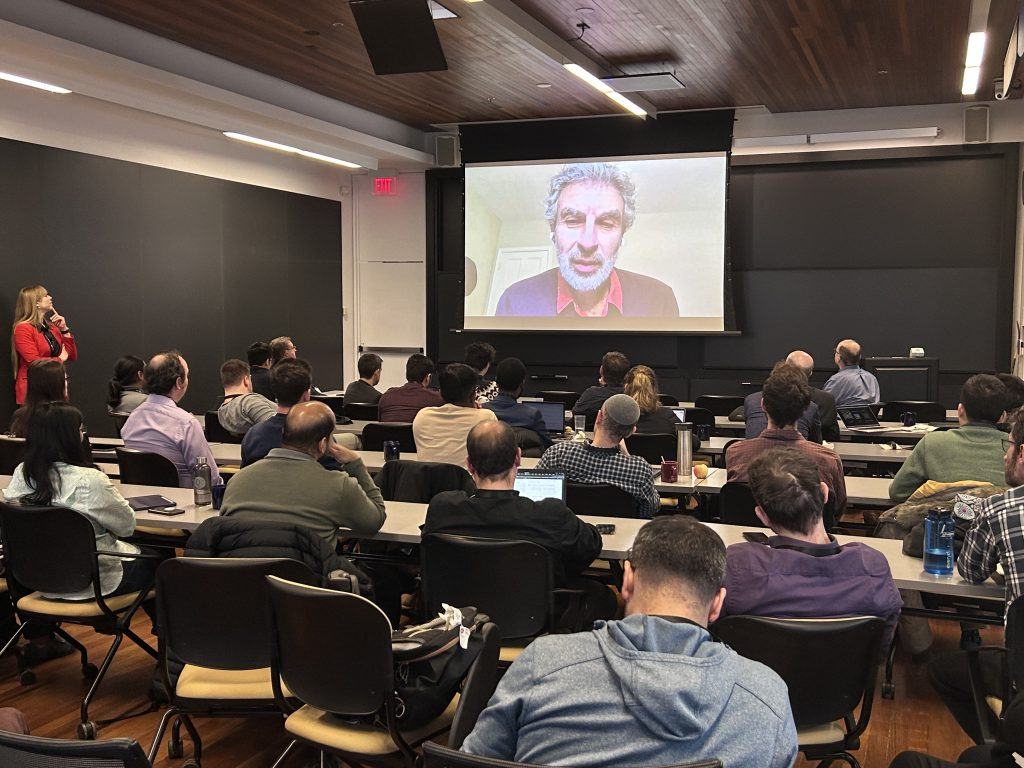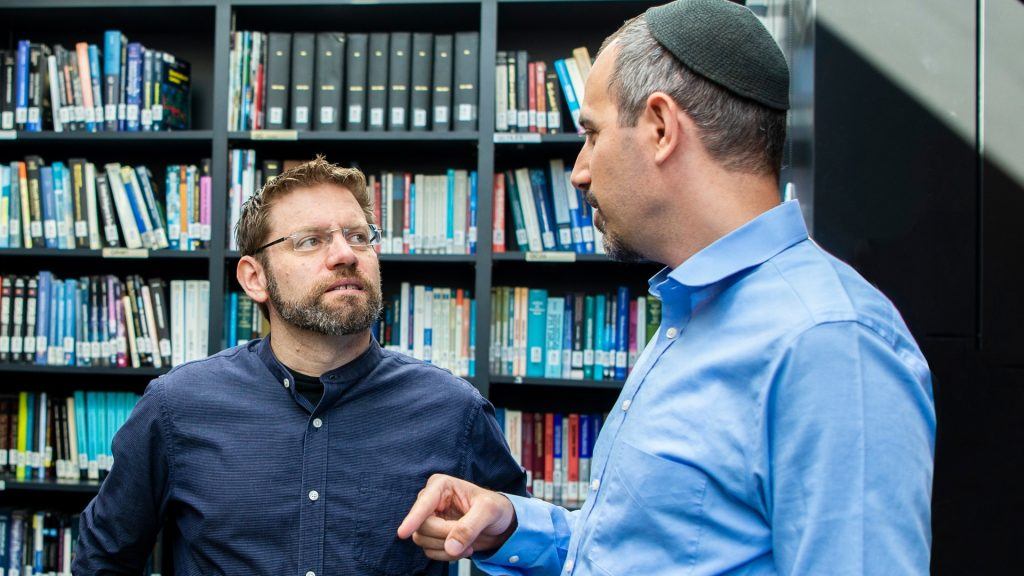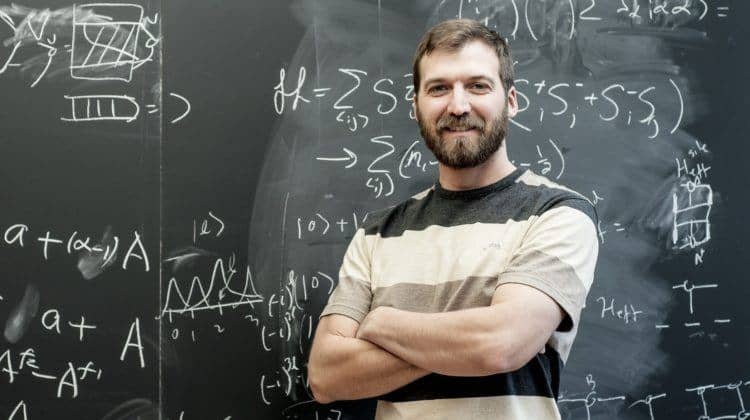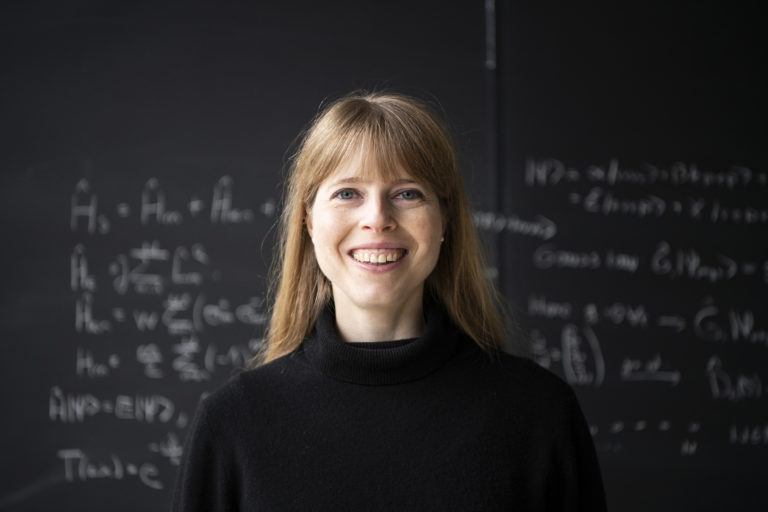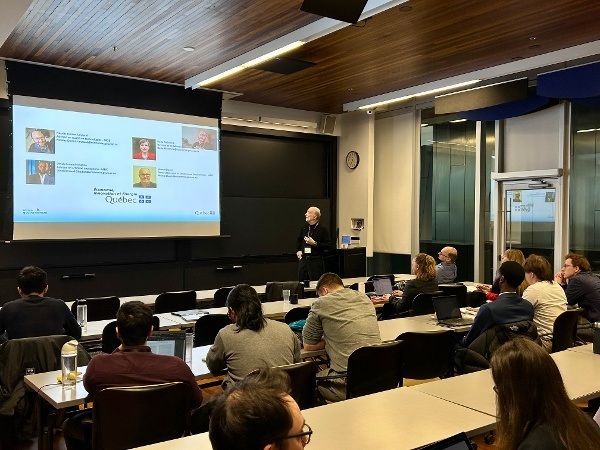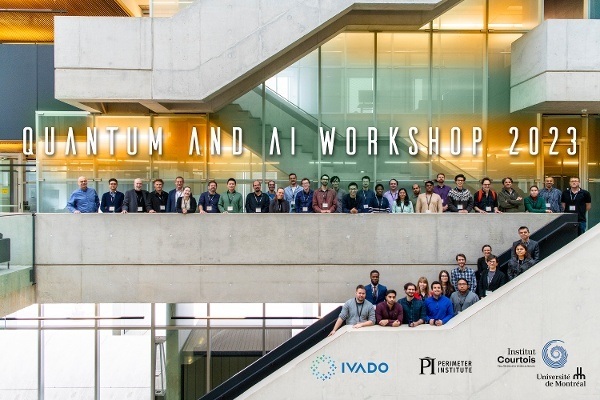The fusion of artificial intelligence (AI) and quantum computing is poised to bring about the next technological revolution, and Canada is leading the way with significant clusters of expertise in both fields.
Now, theoretical physicists from Perimeter Institute and AI experts from Quebec are teaming up to accelerate progress. The end goal: create powerful new computer simulation techniques that will advance chemistry, materials science, pharmaceuticals, climate modeling, and even our understanding of the universe.
In pursuit of these goals and to kick off the collaboration, Perimeter Institute and IVADO – an AI research, training, and knowledge mobilization consortium led by the Université de Montréal and its university partners in Canada – held a quantum and AI workshop in November that featured a keynote talk from Yoshua Bengio, who is known worldwide as one of the “godfathers of AI.”
The collaboration also includes two of IVADO’s academic members in Quebec: Institut Courtois, which brings together leading researchers in chemistry, physics, and computer science to accelerate AI discoveries, and Mila, an artificial intelligence centre in Quebec that boasts the largest concentration of deep learning academic researchers in the world.
The workshop was hosted at Perimeter and led by Christine Muschik, a Perimeter associate faculty member who is cross-appointed at the University of Waterloo’s Institute for Quantum Computing. IVADO’s research support team helped organize and fund the workshop.
Bengio, who is the scientific director at IVADO and Mila, is a professor at the Université de Montréal. In 2018, he won the Turing Award, “the Nobel Prize of Computing,” with Geoffrey Hinton (another Canadian, from the University of Toronto) and Yann LeCun, chief AI scientist at Meta.
Lately, he has been thinking deeply about how to create artificial intelligence that is both useful and safe. He is working on what he calls “AI scientists,” a type of AI that could generate new theories, while ensuring a safe alignment between AI and human goals. “What I am proposing could be very useful, because it could help us with our science, but it could also help us build safe systems,” Bengio said at the workshop.
Artificial intelligence is the science of simulating human intelligence in computer programs. It involves feeding a lot of data into a computer and having it “learn” from that data. Many people are familiar with OpenAI’s ChatGPT model, but there many other AI systems today that are also generating text, images, music, and other media. AI is also finding applications in medical technology, in spotting patterns in astronomy data, in clean energy research, and in materials science.
There is now a global race to build artificial general intelligence (AGI) that can multitask and even surpass the abilities of the human brain. But there is also a risk that AI systems learn what we don’t want them to learn. Bengio believes both the risks and the enormous potential are real, and we need to find a way to exploit the potential while minimizing the risks.
“There's no reason to think that human intelligence is the upper bound of intelligence,” Bengio said. That raises difficult philosophical questions such as: What is the role of humans if these AI systems are smarter than us? People don’t have the answers to that yet, but Bengio said in the meantime, “AI might help us advance our science and solve useful problems.”
Achieving that will require expertise of the sort that can be found in spades at Perimeter.
“The problems I'm trying to solve require mathematical sophistication that computer scientists usually don’t have, but mathematicians or physicists are more likely to have, and so there are opportunities for collaborations here along those lines,” Bengio said.
The recent workshop was aimed at building new research connections between experts in quantum and AI.
Robert Spekkens and Elie Wolfe, who work on techniques for disentangling correlation and causation from statistical data, are examples of Perimeter scientists whose work might feed into the improvement of algorithms for artificial intelligence.
While AI systems today are wonderfully capable of pattern recognition, such as spotting tumours in X-rays, the hope is that if AI can become good at understanding cause-effect relationships from the data, it could also become better at analyzing the most likely cause of someone’s chest pain, as an example. This is where their quantum causal inference research could play an important role.
“You could think of causal inference as a subfield of machine learning,” Spekkens said in an interview after the conference. “Causal reasoning is one of the missing pieces in our best AI systems right now. There is something called causal representation theory, which neural networks and tools of machine learning use to try to get at causal structures. We are moving into that space and there is potential for useful interactions with people at Mila,” Spekkens said.
Meanwhile, Roger Melko – a Perimeter associate faculty member who is cross-appointed with the University of Waterloo and runs the Perimeter Institute Quantum Intelligence Lab (PIQuIL) – is already working at the intersection of quantum physics and machine learning. The goal is to use AI to design the next generation of quantum computers, but also vice versa; quantum computers could help drive innovation in artificial intelligence.
Melko said the collaboration with AI researchers in Quebec has enormous potential.
“Quantum computers have already begun earnestly adopting AI into their design, characterization, and control stacks,” Melko said. “We are entering a new frontier in scaling quantum computers, aided by language models and other AI technologies.”
He added that it is hard to predict how this collision of quantum computing and AI will play out, “but one thing is clear: the fundamental transformations enabled by the interplay of these two emerging technologies has already begun.”
Meanwhile, Muschik is an example of an expert in quantum simulations who hopes to make use of artificial intelligence.
In a regular or “classical” computer, like your laptop, electrical signals are either going through a system of gates and circuits, or they are not. That generates the strings of ones and zeros that form the basis of all the binary information in our digital world today.
Quantum computing is a step up. Instead of just encoding information in linear strings of ones and zeros, quantum computers exploit the quantum resources of “superposition” and “entanglement” to encode information in “qubits” that are in a state of both zero and one at the same time. But even that is still binary. Nature is not so binary, Muschik explains.
Lately, she has been working with experimentalists at the University of Innsbruck in Austria to take quantum computing beyond “qubits” – the superposition of two states – to “qudits” that exploit higher-dimensional atomic states and will get us closer to computing the way that nature computes.
In the Innsbruck quantum computer, for example, information can be stored in trapped calcium atoms that can each have particles in as many as eight different energy levels that can be in superpositions. So nature makes it possible to have not just qubits, but also “qutrits” (superpositions at three energy levels) or ququarts (four levels) or even higher.
These higher-dimensional superpositions – qudits – allow quantum computer scientists to do more with fewer circuits and gates that cause errors in quantum computations.
Muschik says she and her experimentalist colleagues at Innsbruck have recently found an approach to controlling qutrits, yielding “amazing results.” These are described in a paper, “Simulating 2D lattice gauge theories on a qudit quantum computer,” currently in preprint. “This is the most exciting thing I have done since coming to Canada,” she said.
Muschik and her colleagues believe this higher-dimensional quantum computing could lead to more powerful and efficient quantum simulations that will tackle problems in chemistry or materials science. That’s where new collaborations with the artificial intelligence group at Mila in Quebec can come in.
“With the help of Mila, we can use machine-learning-improved computing to do this,” she says. “We would like to explore new projects under this umbrella.”
“By joining forces, hopefully in a coherent way, the whole can be greater than the sum of its parts,” she added. “We have common interests in making new discoveries. Now is a very good time to be doing this.”
Luc Vinet, chief executive officer at IVADO, says the collaboration with Perimeter is natural and will be powerful. IVADO recently got a $124.5 million grant from the Canada First Research Excellence Fund to support research, teaching, and knowledge transfer in artificial intelligence.
“Perimeter is a fantastic institute with amazing people. At IVADO, we are very multi-disciplinary and we are invested in a very ambitious program. It makes sense that we need to bring together all the best people to achieve our goals,” Vinet said.
Perimeter also fosters the development of young scientists who will make a mark in AI and quantum research across Canada. For example, William Witczak-Krempa, who spoke at the workshop, was a postdoctoral researcher at Perimeter from 2012 to 2015, where he worked applying quantum entanglement in the field of quantum matter. Now, he is a faculty member at the Université de Montréal and at Institut Courtois. He also holds a Canada Research Chair in quantum phase transitions.
Witczak-Krempa said his career path “was made possible because of the interdisciplinary nature of Perimeter.”
“There’s so much to do, and I think physicists will play an important role because one has to understand the physics to design the right architecture,” he said of the collaboration.
The collaboration between Perimeter, IVADO, Institut Courtois, and Mila is just getting started, and the possibilities have everyone itching to begin.
“It was great to learn about the research being done in Montreal and to see so many enthusiastic conversations between the two groups,” said Perimeter Institute’s director, Robert Myers. “I look forward to seeing the joint activities that emerge from this inaugural meeting.”
About PI
Perimeter Institute is the world’s largest research hub devoted to theoretical physics. The independent Institute was founded in 1999 to foster breakthroughs in the fundamental understanding of our universe, from the smallest particles to the entire cosmos. Research at Perimeter is motivated by the understanding that fundamental science advances human knowledge and catalyzes innovation, and that today’s theoretical physics is tomorrow’s technology. Located in the Region of Waterloo, the not-for-profit Institute is a unique public-private endeavour, including the Governments of Ontario and Canada, that enables cutting-edge research, trains the next generation of scientific pioneers, and shares the power of physics through award-winning educational outreach and public engagement.
You might be interested in



